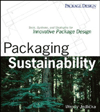INCPEN guide tackles the problem of left-behind product

INCPEN (incpen.org) – the Industry Council for research on Packaging & the Environment - has produced a guide that helps manufacturers, retailers and pack designers tackle the problem of Unintentional Product Residue (UPR), the waste in a pack which a consumer either can’t get out, or can’t be bothered to get out or doesn’t know is there.
Following a proposal made by Boots UK to help us understand the issue, INCPEN and WRAP – the Waste and Resource Action Programme - commissioned a study by Leatherhead Food Research. This identified the reasons why UPR occurs for a number of products widely used by consumers and the steps that producers should consider to prevent it.
Leatherhead examined 362 samples covering a range of regularly used foods, cosmetics, toiletries, cleaning products and DIY products. Significantly, over two-thirds contained less than 1% UPR, while only 7% had more than 5%.
UPR can have both negative economic and reputational implications. Residues are an environmental and financial cost as the unused product wastes the raw materials, water and energy that were used to produce it and this has an impact on the cost of manufacturing, processing and distribution.
Equally important, consumer attitudes towards a brand may be affected if they are aware that they cannot get all the product out and therefore feel cheated. Residues can also hinder recycling and reduce the yield of recycled material.
The INCPEN guide, ‘The Bit at the Bottom. A guide to help consumers get the last bit out, seeks to support manufacturers’ existing efforts by highlighting areas that should be taken into consideration early in the product development process. These include the nature of the product, the design of its packaging and how consumers use the product and its pack.
It provides a variety of practical suggestions on how to make it easier to extract the last bit of product, while stressing the need to ensure the packaging is exactly tailored to the product. It also contains a useful checklist.
“Nearly all of us will have experienced the frustration of not being able to access ‘the last bit’ of product,” says INCPEN director Jane Bickerstaffe.
“Many manufacturers already minimize UPR. Our guide supports their initiatives with advice on steps that can be taken in the early stages of product development.”
The Bit at the Bottom guide can be downloaded from http://bit.do/INCPEN-UPR
Looking for a reprint of this article?
From high-res PDFs to custom plaques, order your copy today!










